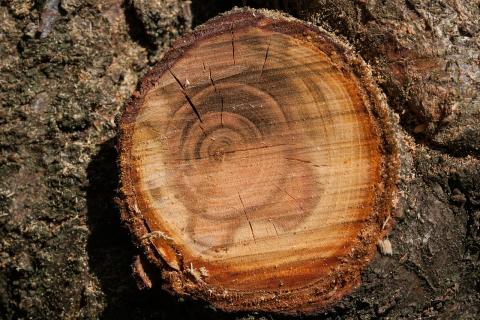Should I cover large pruning wounds with a tree wound dressing?

In decades past, recommendations were often made to apply tree paint to wounds. The idea was that this paint would prevent decay, help speed healing, and improve the appearance of the cut. Although these claims have been debunked for years, there are still many tree wound dressing products that can be purchased online or at garden supply stores. Many of them are petroleum-based and advertised as being waterproof and flexible to keep insects and fungi from invading the pruned areas. Better yet, some of these same products claim they can be used for multiple purposes, from waterproofing and sealing gutters and roof flashings, to protecting the undersides of lawnmower decks. Clearly, these materials don’t seem like they would be healthy to apply to living tissue. I certainly wouldn’t want to get a tree dressing on my own skin, let alone a cut or scrape.
In reality, pruning paint may impede healing and encourage the growth of rot organisms and insect infestation. Rather than seal out infection, wound dressings often seal in moisture and decay. In most cases, it is best to simply let wounds seal on their own. Over millennia, trees have developed effective mechanisms for this. Unlike people or animals, woody plants are unable to heal damaged tissues. Instead, they compartmentalize wounds with layers of cells that prevent damage from spreading any further. A properly pruned tree or shrub will seal off wounds and prevent decay organisms from entering the trunk. Naturally, small wounds seal much faster than large ones, making a clear argument for pruning and training plants when they are young.
By the same token, you should never attempt to fill large cracks or holes in trees. Although it may be tempting to plug a large opening with cement or foam, neither of these materials will bond with the wood of the tree and they will hold moisture, speed the development of wood decay fungi, and obstruct the natural compartmentalization process. A better approach is to monitor the tree’s health and consult with a certified arborist if you think it might become a hazard.
Are you interested in trying to save broken branches on your tree? Read this related question of the week.
Do you love learning about stuff like this?
SUBSCRIBE TO GRANITE STATE GARDENING
A monthly newsletter for New Hampshire gardeners, homesteaders and plant-lovers of all kinds, that includes seasonal suggested gardening tips, upcoming events and articles with proven solutions for your garden and landscape.
Got questions? The Ask UNH Extension Infoline offers practical help finding answers for your home, yard, and garden questions. Call toll free at 1-877-398-4769, Monday to Friday, 9 a.m. to 2 p.m., or e-mail us at answers@unh.edu.
